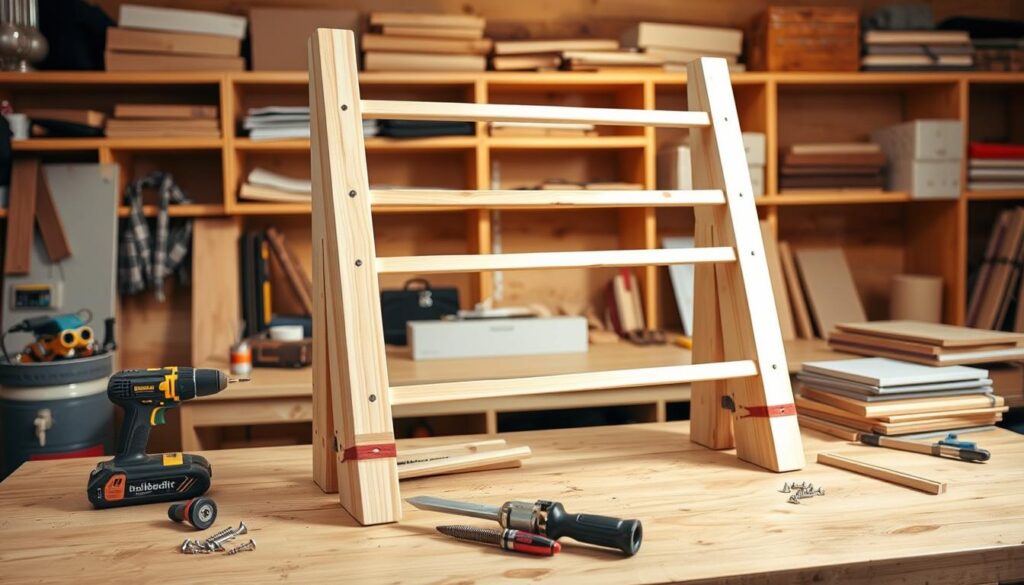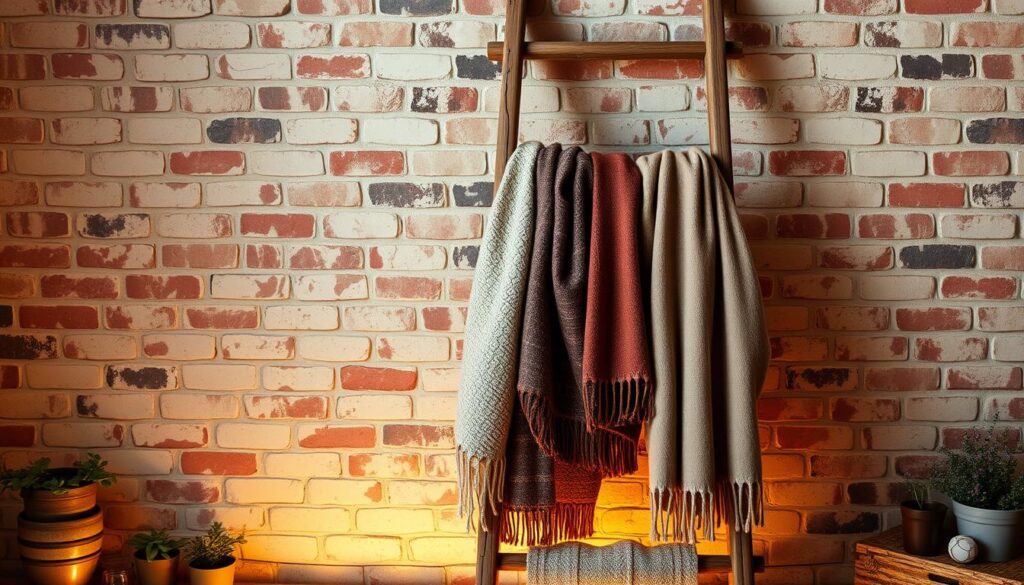Looking for a quick, budget-friendly way to add rustic charm to your home? A farmhouse-style DIY wooden blanket ladder might be just what you need. For under $15 and less than an hour of work, this project blends creativity with practicality. Whether you’re storing cozy throws or showcasing decor, it’s a versatile addition to any room.
Why spend $40 or more on store-bought versions when you can customize your own? Adjust the height, width, or finish to match your space perfectly. Paint it white for a cottage vibe, stain it for warmth, or leave it natural for a raw, organic look. The choice is yours!
This isn’t just for blankets, either. Use it in playrooms to organize toys, in offices to display plants, or even in bedrooms as a towel rack. The step-by-step guide makes assembly simple—no advanced tools required. Grab some lumber, a drill, and let’s turn your vision into reality!
Key Takeaways
- Build a stylish, functional ladder for under $15 using basic tools.
- Customize the design to fit your decor preferences and room dimensions.
- Complete the project in under an hour, ideal for beginners.
- Use the ladder in multiple spaces, from living rooms to home offices.
- Save up to 70% compared to pre-made retail options.
Getting Started with Your DIY Project
Kickstart your DIY journey with a practical and stylish home accessory. Before grabbing your tools, let’s break down the essentials for success. A little preparation now saves time and ensures your creation fits seamlessly into your space.
Gathering Materials and Tools
You’ll need basic supplies available at any hardware store. 2×4 pine boards or standard lumber work best for sturdy rails. Add deck screws, sandpaper, and stain or paint for finishing touches. Most items cost under $5 each—perfect for tight budgets.
Essential tools include a drill, tape measure, and miter saw. No saw? Stores like Home Depot offer free wood cutting. Grab felt pads too—they protect floors when your project is complete.
Deciding on Dimensions and Placement
Measure your wall space before cutting wood. A 6-foot height with 18-inch width balances most rooms. Space rungs 12 inches apart for optimal functionality. Adjust these numbers if you’re hanging bulkier items or fitting into compact areas.
Mark your wall with painter’s tape to visualize the final look. This trick helps avoid awkward gaps or overcrowding. Remember: Planning ensures your handmade piece becomes a focal point, not an afterthought.
Step-by-Step Guide to Building Your Blanket Ladder
Ready to transform raw materials into a functional decor piece? This hands-on walkthrough makes woodworking approachable for first-timers. We’ll break the process into three manageable phases—from precise cuts to final decorative touches.

Cutting and Preparing the Wood
Start by measuring twice and cutting once. Use a miter saw to create:
- 2 vertical posts (72″ tall)
- 5 horizontal rungs (18″ wide)
Safety first! Wear goggles when cutting. Sand all edges with 120-grit paper to prevent splinters. Wipe surfaces with a tack cloth to remove dust.
Assembling the Structure with Ease
Lay posts parallel on a flat surface. Mark rung positions 12″ apart. Clamp pieces together before drilling pilot holes. Secure each joint with 3″ deck screws—this prevents wood splitting.
| Tool | Purpose | Pro Tip |
|---|---|---|
| Cordless Drill | Create pilot holes | Use #8 drill bit |
| Speed Square | Ensure 90° angles | Check after each screw |
| Bar Clamps | Hold pieces steady | Use 2+ for stability |
Finishing Touches: Surface Prep & Staining
Apply Minwax Dark Walnut stain using lint-free cloths. Work in sections, wiping excess after 5 minutes. For farmhouse style, lightly sand edges after drying to reveal raw wood beneath.
Ventilation matters! Open windows when using oil-based products. Let cure 24 hours before use. Optional: Add decorative hooks or metal accents for personality.
Adding Rustic Charm and Personal Touches
Your handmade creation becomes truly special when infused with character. Let’s explore how to elevate its visual appeal while maintaining functionality.

Incorporating Decorative Elements
Transform your piece into a dynamic display with simple additions. Drape a woven wreath over the top rung for instant texture. Swap it seasonally—pinecones for winter, dried flowers for spring. Attach small hooks to hang string lights or trailing ivy.
Consider practical accents too. Hang a macramé plant holder from the side or clip photos to the rails with decorative clothespins. These touches blend style with purpose.
Customizing the Ladder to Fit Your Space
Match your room’s vibe through finishes. For industrial lofts, try matte black paint with exposed screw heads. Coastal spaces shine with whitewash and rope details. Mix stains like dark walnut and weathered gray for depth.
Adjust proportions if needed. Narrower designs (14″ wide) suit tight corners, while taller versions (7-8 feet) make bold statements in vaulted rooms. Pro tip: Test samples on scrap wood before committing.
Pair your creation with coordinating textiles. Chunky knit throws in neutral tones enhance farmhouse style, while geometric patterns lean modern. Let your personality guide every choice!
Conclusion
Crafting your own home decor brings both pride and practicality to everyday living. This blanket ladder project proves that with basic tools and a dash of creativity, you can build something beautiful in under an hour. Whether you’re organizing throws, plants, or towels, your handmade piece adapts to any room’s needs while saving up to 70% over store prices.
From selecting lumber to applying the final stain, each step empowers you to shape the design. Adjust measurements for tight corners or tall ceilings. Experiment with finishes—try distressed paint for vintage flair or metallic accents for modern edge. Those personal details turn functional wood into a conversation starter.
Share your creation online to inspire others! Got questions or fresh ideas? Drop them below. Ready for your next DIY challenge? Tackle floating shelves or a rustic coffee table next. Happy building!

